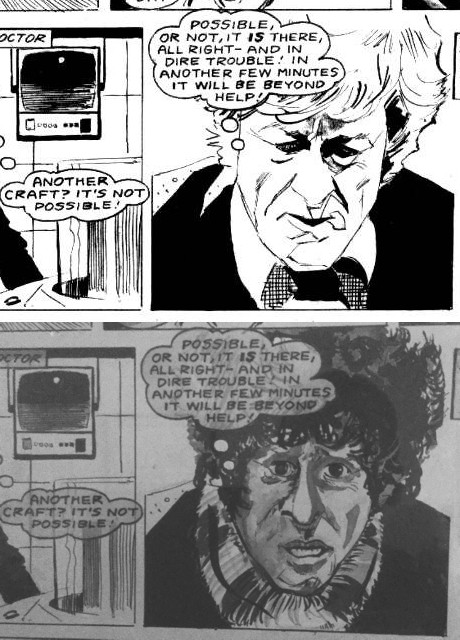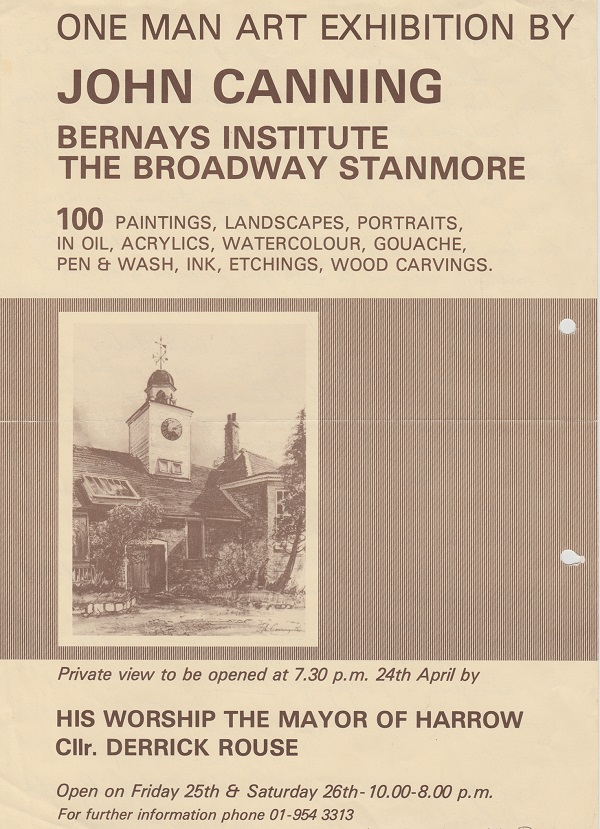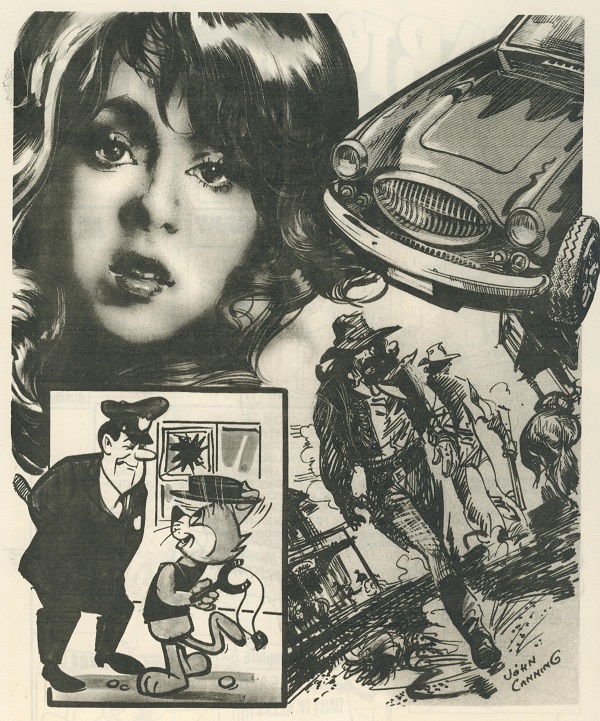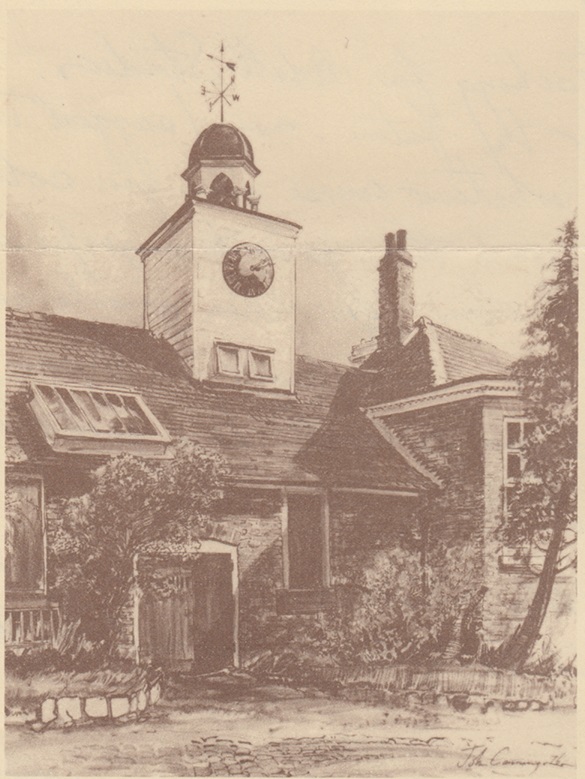Born in London in 1923, John Canning went to the Hornsey College Of Art in Haringey before becoming a military pilot during WWII. After the war he did commercial and advertising work before going freelance in 1948. As a comic strip artist however we can see his work in Swift, Girl, Express Weekly, Lady Penelope and especially his long career with TV Comic. His best known strip from TV Comic is Doctor Who for which he illustrated the first four television Doctors from 1966 through to 1971 and then again from 1975 to 1978.
For the December 1981 issue of the Doctor Who fanzine Views, News and Reviews (VNR) Paul Vyse asked Canning if he watched Doctor Who on the television, “Never!” was the reply, quickly followed by an answer that you would not perhaps have expected from an artist who had worked on television related strips in TV Comic for upwards of twenty years, “I hate television!”
downthetubes is pleased to reprint, with Paul Vyse’s permission, a second interview with 1960s and 1970s TV Comic Doctor Who artist John Canning.
*****************************************************
VIEWS, NEWS AND REVIEWS, ISSUE 7, DECEMBER 1981
V.N.R. QUESTIONNAIRE – JOHN CANNING

I expect many of you out there used to buy the popular children’s comic TV Comic just to read the exciting adventures of our favourite Time Lord, and often wondered who was responsible for the superb artwork of this gem of British comicdom. Well, John Canning was that man, a well-established comic artist, who worked mainly for TV Comic after considerable success with several strips in “Swift”, a comic that ran from 1954 to 1963.
The first comic strip of Doctor Who he did for TV Comic starred William Hartnell who was accompanied by two young children, John and Gillian, who later left and were replaced by Jamie when Patrick Troughton was brought in.
John drew Tom Baker from 1975 to 1979, when the strip was discontinued in TV Comic. He then went on to draw, still for TV Comic, Charlie’s Angels in 1979 and then Dukes Of Hazzard in 1980-81. He is currently not illustrating for TV Comic, but I, and many others, hope it will not be long before his familiar style graces the pages of TV Comic again.
I would like to extend my sincere thanks to John Canning for taking time to fill in the questionnaire printed below. (P.A. Vyse)
WHAT FORMAL TRAINING DID YOU HAVE AS AN ARTIST?
Saturday mornings at Hornsey Art School, then evenings, then full-time for three years
HOW LONG HAVE YOU BEEN DRAWING COMIC STRIPS?
About 25-30 years
HAD YOU AN AMBITION FROM CHILDHOOD TO BE AN ARTIST, AND IF NOT, WHICH OTHER AMBITIONS HAD YOU IN MIND?
I could not do anything else, so I had to
WHAT WAS YOUR FIRST COMIC STRIP, AND IN WHAT MAGAZINE WAS IT PUBLISHED?
“Adventures Of The Ladybird Club”, I’ve forgotten the name of the mag.
WHEN DRAWING COMIC STRIPS DO YOU LIKE TO REFER TO PHOTOGRAPHS?
You must do if you do not know the character.
YOU ILLUSTRATED TOM BAKER’S DOCTOR FROM 1975 ONWARDS, STARTING WITH A STORY CALLED “THE EMPEROR’S SPY”. DID YOU HAVE ANY SAY IN THE DOCTOR WHO STORIES YOU ILLUSTRATED?
None at all
WHICH DOCTOR’S COMIC STRIP DID YOU FIND MOST ENJOYABLE TO DRAW?
They’re all the same to me.
WHICH ACTOR WHO HAS PORTRAYED DOCTOR WHO DID YOU FIND EASIEST TO DRAW AND WHY?
It didn’t matter.
ALTHOUGH THE STRIPS IN TV COMIC WERE IN BLACK AND WHITE, THOSE IN THE TV COMIC ANNUALS WERE IN COLOUR. DO YOU FIND BLACK AND WHITE MORE ENJOYABLE?
No
DO YOU EVER WATCH THE DOCTOR WHO SHOW ON TELEVISION?
Never! I hate television!
HAVE YOU EVER DRAWN THE DOCTOR FOR ANY OCCASION OTHER THAN A COMIC STRIP? (IE A ONE OFF MAGAZINE ILLUSTRATION)
Not that I can recall
IN ANY COMIC STRIP DO YOU DO YOUR OWN SPEECH BALLOON LETTERING, OR DO YOU HAVE A SEPARATE LETTERER TO DO THAT FOR YOU
Never, as you can see my writing is terrible (Thomson’s (DC Thomson, the comic publishers – Ed.) now do their lettering by print!).
WHAT COMIC STRIP, IF ANY ARE YOU CURRENTLY DRAWING NOW THAT “DUKES OF HAZZARD” HAS ENDED IN TV COMIC?
“Judy” for DC Thomson, also the Bunty Library, also Halas and Batchelor “Billy Sport” for Germany
THROUGH YOUR COMIC STRIPS IT IS OBVIOUS THAT YOU ENJOY DRAWING, BUT DO YOU LIKE PAINTING? DO YOU DO ANY PAINTINGS OR DRAWINGS AT HOME FOR PLEASURE?
I enclose a leaflet of my show.
*****************************************************
TV Comic ran for 1697 issues from the first issue dated 9 November 1951 through to the final issue dated 29 June 1984, beginning as a nursery comic using television characters, its format changed through the years to increase the age range of its intended audience with strips based on family entertainment drama series before tending to television related humour strips in its final years. Those TV Comic strips based on fan favourite series such as Gerry Anderson’s Four Feather Falls, Supercar and Fireball XL5, BBC’s Doctor Who, and ITV’s The Avengers are well served for information, but unfortunately as a whole the comic is poorly documented.

Of those fan favourite series John Canning worked on both Doctor Who and The Avengers strips. For The Avengers he illustrated the Tara King adventures in black and white for the duration of 1969, ten different stories running from issue 890 (4 January 1969) to issue 941 (27 December 1969).

For Doctor Who he took over from artist Bill Mevin with a First Doctor strip in issue 748 (16 April 1966) and completed a total of 3 colour stories through to issue 762 (23 July 1966) immediately followed by 5 black and white First Doctor stories in the weekly up to 783 (17 December 1966) plus 2 duotone stories in the 1966 Holiday Special and 1 colour story in the 1967 cover dated annual.
His Second Doctor stories began the next week in issue 784 (24 December 1966) and ran mainly in black and white through to issue 823 (23 September 1967) although the issues from 788 through to 809 (21 January to 17 June 1967) all include colour covers as part of the strip. With issue 824 the strip moved into colour and stayed that way until issue 880 (26 October 1968). They then ran from issue 881 the next week until issue 936 (22 November 1969) in the weekly comic plus one colour and one duotone strip in each of the 1969 and 1970 cover dated annuals.

As with the series on television, the strip in TV Comic paused over Christmas 1969 before Canning returned with the Third Doctor in issue 944 (17 January 1970) and continued on in black and white until issue 999 (6 February 1971) after which the strip was moved to Countdown/TV Action with different artists although Canning did do his one colour and one duotone strip in the 1971 cover dated annual.
The Doctor Who strip returned to TV Comic with issue 1133 (1 September 1973) with Gerry Haylock’s black and white Third Doctor art but it would be issue 1232 (26 July 1975) when Canning returned to the strip with black and white Fourth Doctor tales and continued straight through to issue 1385 (30 June 1978). He would also have colour strips in the 1977, 1978 and 1979 TV Comic annuals and a black and white strip in the 1977 Holiday Special.

From the story The Amateur, Gerry Haylock’s original Third Doctor from TV Comic 1148, 15 December 1973, and Canning’s replacement Fourth Doctor from TV Comic 1390, 4 August 1978
With issue 1386 TV Comic began a run of black and white reprints of Second and Third Doctor reprints for which Canning replaced the faces of the original Doctor with that of the Fourth Doctor, a process which continued through to issue 1430 (11 May 1979) after which the title’s publishers, Polystyle, gave up the Doctor Who licence. It is a shame that for all his work on Doctor Who and many other strips in TV Comic and other weekly publications through four different decades this “doctoring” of Doctor Who comic strips is what John Canning is often best remembered for.
TV Comic writer Roger Noel Cook was interviewed by Stuart Palmer for his excellent Altered Vistas site on Doctor Who comics. Cook wrote many of the TV Comic Doctor Who scripts from the First Doctor in 1966 through to the earliest Third Doctor strips in 1970 and he says of Canning, “John Canning was the first artist to ‘get’ the Doctor! The Troughton period was visually the most satisfying in my opinion.”
Discussing the Doctor’s TV Comic grandchildren, John and Gillian, Cook says that “from John Canning’s point of view” they “made the frames over-crowded a lot of times” which he considers was part of the reason that the characters were eventually dispensed with. In that interview Palmer faces up to Canning’s art style with the comment, “He could be a bit scrappy at times, though, especially in the annuals” to which Cook replies, “Canning was guilty of appalling haste with the annual work which he dashed off for what he considered to be a pittance.”
In addition to Doctor Who and The Avengers, between them the Tardis and VNR interviews and SSI Strips 80 list the following TV Comic strips that Canning worked on: Cannon, Captain Caveman, Charlie’s Angels, Dukes Of Hazzard, Goodbye Mr. Chips (film adaptation), Laurel and Hardy, The Maryland Gang, The Milky Bar Kid, The Sign Of The Scarlet Ladybird, Star Trek, Tarzan, Top Cat, and Skippy. It should be pointed out that the Ladybird clothes advertising strip appeared in both Swift and TV Comic in the mid 1950s, but whether they were the same in both comics each week has yet to be ascertained.

John Canning’s answers to Paul Vyse’s 1981 questions posed by letter do appear to be very abrupt but he also wrote Paul a previously unpublished covering letter. In it he says “I came home from my skiing holiday in Switzerland with a dislocated shoulder. At the same time I got the SACK from TVC for the artwork for The Dukes Of Hazzard not being up to standard, and that is after working for TV Comic for about 20 years! I had made the mistake of putting too many eggs in one basket. I had to start looking around for work again.”

Part of that work was “some teaching for Adult Studies” while his artwork began appearing in DC Thomson’s weekly Judy comic and in their Bunty Picture Library. As stated in the VNR interview he also worked for British animation studio Halas and Batchelor on their 1979 series of 26 x 30 minute episodes Bravo For Billy which was based on the German Sport Billy comic character. Unfortunately any details on what this Halas and Batchelor work entailed have yet to emerge.

Canning’s 1980 art exhibition at what is now Bernays Memorial Hall
Canning’s training at the Hornsey College of Art was in fine art and painting and his SSI bio says that he had etchings accepted by the Royal Academy during WWII. The Tardis interview shows that in 1976 he was interested in putting on his own exhibition which finally happened in 1980 at Stanmore in North London and featured 100 items in oils, acrylics, pen and wash, etchings, wood carvings and other mediums.
His letter to Paul Vyse ends with “You may be interested to know that all the paintings that were for sale were sold,” although he then adds, “(except for 5) but they were rotten anyway.”
The mention of a skiing accident in the letter shows that Canning enjoyed raising his heart rate through sport and speed. His SSI details state that he “goes ‘jogging’ each morning and participates in an astonishing variety of energetic sports! His affection for his motorcycle is justified by the relative ease with which he can make deliveries in town!”
Is John Canning still with us? At the time of writing no one seems to know for certain, and he would be 93 if he was, but if he or his family should read this then I hope that they would be pleased to know that he is still thought of and is well-regarded for his comic strip work through four different decades.
• The first part of this Words From Beyond feature on John Canning featuring a 1976 Tardis interview is here.
• There are more details of John Canning’s TV Comic Doctor Who work on the Altered Vistas website. The full Altered Vistas interview with Roger Noel Cook is here
• There are more details of John Canning’s TV Comic Avengers work on the Winged Avenger website
• There are full strips of TV Comic Doctor Who stories on the WhoPix website
• A full set of TV Comic Annual covers is available at Tonys Trading website
• Detailed information on all Doctor Who comic strips is available in Paul Scoones’ excellent The Comic Strip Companion – The Unofficial and Unauthorised Guide to Doctor Who in Comics: 1964-1979 which is published by and available from Telos
With thanks to Jeremy Bentham, Gordon Blows, Ray Carnes, John Freeman, Chris McGregor, Richard Sheaf, Lew Stringer and Paul Vyse
News, reviews, interviews and features for print and on-line: Spaceship Away (since October 2005), Bear Alley (since February 2007), downthetubes (since June 2007), and Eagle Times (since October 2008). Plus DC Thomson’s The Art Of Ian Kennedy, Titan’s Dan Dare and Johnny Red reprints, Ilex’s War Comics: A Graphic History and 500 Essential Graphic Novels, and Print Media’s The Iron Moon and Strip magazine.
Categories: British Comics, Creating Comics, downthetubes Comics News, downthetubes News, Features






 The SEQUENT’ULL Interviews: Dan White
The SEQUENT’ULL Interviews: Dan White  The SEQUENT’ULL Interviews: Michelle Freeman
The SEQUENT’ULL Interviews: Michelle Freeman  The SEQUENT’ULL Interviews: Colossive Press
The SEQUENT’ULL Interviews: Colossive Press  The SEQUENT’ULL Interviews: Comic Creator Mark Stafford
The SEQUENT’ULL Interviews: Comic Creator Mark Stafford
I loved reading about John. I was at school with his eldest daughter Lisa, a talented artist when there but had M.S. by the time she was in her 20s. I was also his postman for around 5 years. I can remember him jogging in the mornings and he would wave from his motorcycle when he saw me out delivering. It took me ages to realise it was him because of the helmet, goggles, scarf and the fact he kept the bike in the garage rather than his old VW Beetle. Lovely man.
That’s a wonderful story, thanks for sharing these memories Peter!
Canning also did some work for the final issue of the short-lived computer themed comic ‘Load Runner’ in 1983, viewable online here: https://archive.org/stream/LoadRunnerComicBookCollection/LoadRunner13dec1983#page/n23/mode/2up
I’m surprised this is isn’t better known as it’s much more striking and atmospheric than his TV Comic work.
That’s some great art in Load Runner, but it’s by John Stokes, who also worked for Marvel UK and has been drawing strips for the recent Scream and Misty specials… he also drew the strip “Marney the Fox“, collected by Rebellion back in 2017.
The ‘Andy Roid’ strip in Load Runner was by John Stokes but I was referring to the ‘Simian’s World’ strip on the opposite page, which is both recognisably Canning’s work and is credited to him.
D’oh! The perils of opening these kind of pages on a smaller screen… lovely work! Thank you